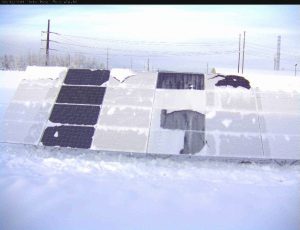
A photovoltaics (PV) research team led by Sandia National Laboratories recently learned that their journal article, “Facilitating large-scale snow shedding from in-field solar arrays using icephobic surfaces with low-interfacial toughness,” was chosen as an Editor’s Pick and is featured in the annual Best of Advanced Materials Technologies issue.
The Best of Advanced Materials Technologies 2021 presents the editors’ selection of top articles published by the journal in that year. The journal has a particular focus on advanced device design, fabrication, and integration, as well as new technologies based on novel material and bridges the gap between fundamental laboratory research and industry.
“The development of snowphobic coatings, which can be applied to photovoltaic (PV) modules, without compromising light transmissivity, have true game-changing potential for PV power plant efficiency in cold climates,” says Laurie Burnham, PI for a larger project on PV optimization at northern latitudes under which this work falls, and the generator of the idea. “Sandia is very proud of this coatings work, which was largely done at the University of Michigan, and funded by Sandia, with additional technical support provided by the University of Alaska, Fairbanks.”
Large-scale accrual of snow and ice on solar arrays in the northern latitudes can cause significant power losses during winter. The many variations in snow morphology — from dry snow to bulk ice — have made the development of a passive, broad-spectrum snow, and ice-shedding surface challenging. The authors have developed one of the first surfaces that simultaneously possesses low-interfacial strength and toughness with ice. Their preliminary evidence indicates that the new surfaces can shed different types of snow and ice from field-deployed arrays over a range of subzero temperatures over several weeks, leading to significant increases in power generation.

Read the complete article.
Read more about the PV Optimization at Northern Latitudes project.
Learn more about Sandia’s Photovoltaics Solar Energy program.
June 7, 2022